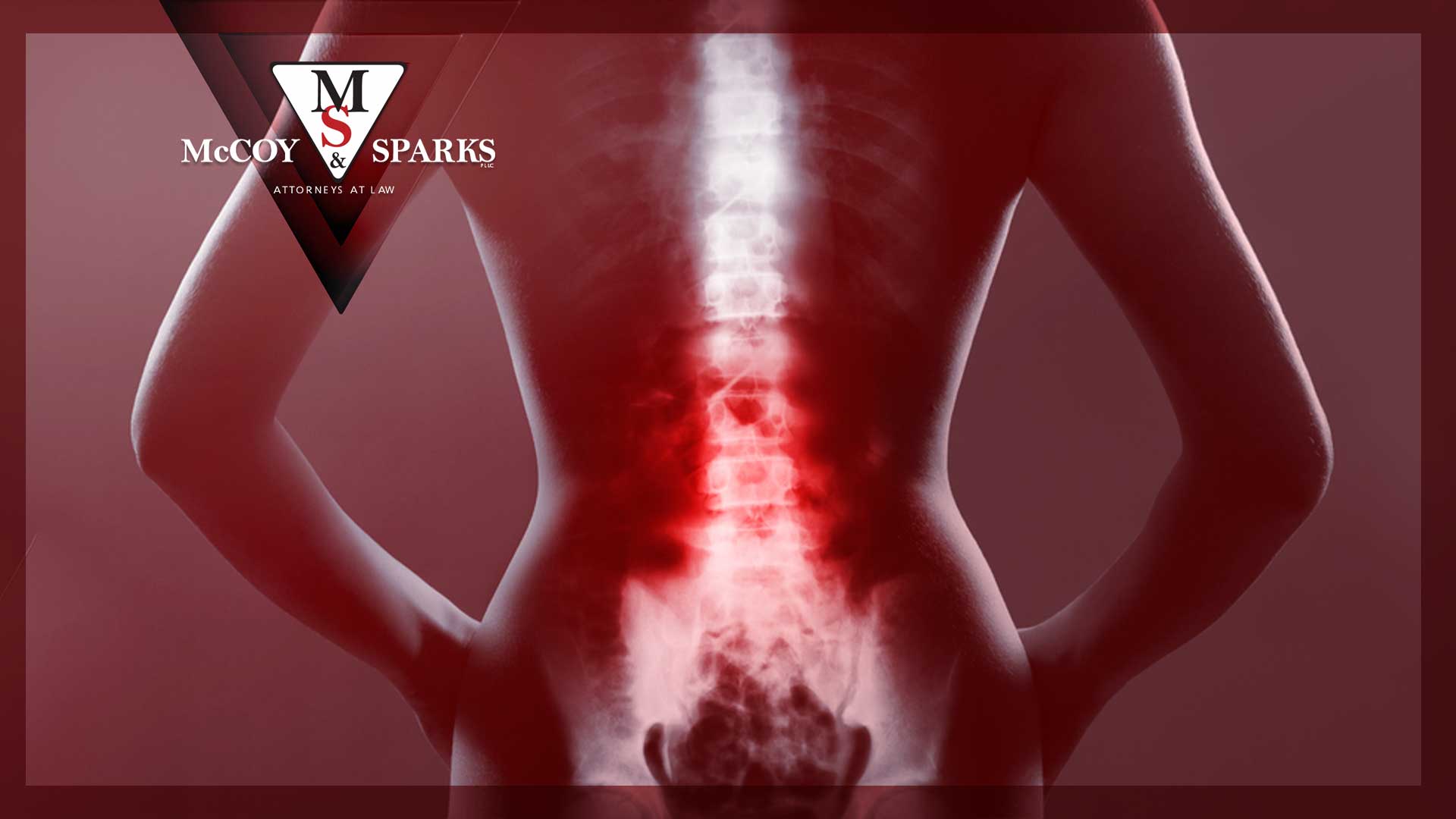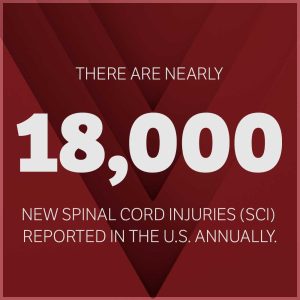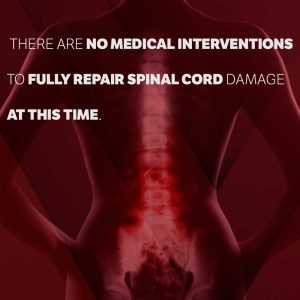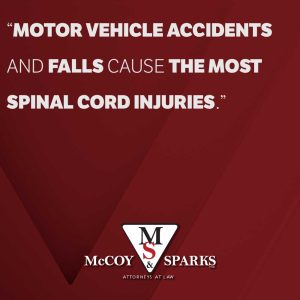
Spinal cord injuries can occur due to various circumstances, each with its own set of challenges and possible side effects. Sports injuries, like a head injury or blunt injury, particularly those involving high-impact or contact sports, pose a risk of spinal cord trauma. A medical emergency, such as sudden falls or accidents, can also lead to injuries affecting the central nervous system. Motor vehicle crashes, involving significant force, may result in head injuries, bone fractures, or blunt trauma affecting the spinal cord. Neurological disorders can contribute to injury occurrence, amplifying the risk. When a spinal cord injury occurred, it may have impacted various body functions, leading to respiratory complications and the potential development of deep vein thrombosis. Understanding these potential causes and effects is crucial in promoting awareness and prevention of spinal cord injuries.
Damage to the Spinal Cord Resulting in Injury

There are nearly 18,000 new spinal cord injuries (SCI) reported in the U.S. annually. An SCI can upend the lives of both the injured individual and their loved ones. It can take a tremendous physical and emotional toll on their well-being and quality of life. The majority of SCIs are caused by a traumatic event or accident. Though experimental neurodegenerative medicines are being explored, many spinal cord injuries are still generally considered irreversible. Commonly available treatments focus on compensatory strategies to support daily activity function and quality of life of the injured person after a severe injury.
Throughout the healing process, your time, energy, and resources will be spent maximizing your recovery and quality of life. When the precipitating accident is caused by another party, you may be legally entitled to seek financial compensation. But it can be hard to know where to begin or feel overwhelmed amid such a major life event.
Here we will provide an overview of spinal cord injuries, the long-term impacts on an injured person, and the value of partnering with personal injury experts like the team at McCoy & Sparks.
Anatomy of the Spinal Cord
The spinal cord is an integral structure in the human body. Protected within the bones called vertebrae, the spinal cord consists of millions of nerve cells and nerve fibers that transmit impulses between the brain and your body. More specifically, the spinal cord consists of nerve fibers in spinal nerve roots that extend from the brain down the spinal column through openings between the bones called vertebrae. These nerve roots control voluntary muscle movement, bowel and bladder control, sexual function, and other vital processes.
In terms of its form and structure, the spinal cord extends 18 inches, beginning at the base of your brain stem and extending through your sacral spine. This structure is surrounded by three dense tissue layers (dura mater, arachnoid mater, and pia mater), as well as a cerebral spinal fluid sac and bony spinal canal, to protect the spinal cord.
Additionally, there are 31 levels of nerve branches located in nerve roots extending from the brain and spinal cord that are analogous to the bony vertebral segments (cervical, thoracic, lumbar, and sacral). The spinal nerves at each segment innervate specific muscle fibers that control your voluntary and involuntary motor movements, such as reaching for your glass of water or contracting your diaphragm when breathing.
What Is a Spinal Cord Injury?
A spinal cord injury (SCI) can result from a traumatic injury, illness, or disease process that damages the spinal nerves or surrounding tissue of the spinal column. Spinal cord injuries result in loss of movement, sensation, strength, and vital body regulation functions.
Other common symptoms may include:

- Decrease in or loss of sensation in spinal nerves (touch, temperature, nerve pain, vibration, etc.)
- Loss of movement (paralysis)
- Loss of bladder and bowel control
- Postural changes
- Weakness
- Tingling
- Chronic pain in the head, cervical spine (neck), or back
- Breathing or blood pressure difficulties
As mentioned above, SCIs are typically considered permanent. Though some current research is exploring ways to regenerate damaged nervous tissue, there are no medical interventions to fully repair spinal cord damage at this time.
Causes and Risk Factors for SCI

The majority of SCIs occur due to traumatic accidents or events. Motor vehicle accidents and falls cause the most spinal cord injuries accounting for over 70% of SCI incidences. Violent events, primarily gunshot wounds, are the next most common cause of SCIs. Though less common, medical or surgical events can also lead to severe injury.
Certain populations or groups are more likely to experience a spinal cord injury. Nearly 80% of individuals with an SCI are male. Additionally, people with an average age of 16-30 years old or older than 65 years old are more likely to have a spinal cord injury. Other risk factors for SCI include alcohol use, specific diseases, and lack of proper protective gear (e.g., helmets or seatbelts in motor vehicle accidents).
How Is a Spinal Cord Injury (SCI) Diagnosed?
Your medical team will likely use a combination of diagnostic imaging and neurological testing to diagnose and evaluate a spinal cord injury. Because it can take time for swelling around the cord to subside after an injury, some of these tests may be repeated in the weeks or months following the injury to monitor for any further changes in neurological function. Repeated testing also helps to rule out “spinal shock” which is a temporary loss of neuromotor function after an injury.
Common Causes of Spinal Injury
While it is difficult to predict when and where a spinal cord injury may occur, there are several situations where this type of injury is common.
These include:
Vehicle crashes: The sudden stop from a high-speed crash can severely damage the spine.
Falls: Falling from significant heights can fracture, dislocate, or compress parts of the spine.
Sports/Recreation Activities: Contact sports can carry risks of spinal cord injuries from direct blows or improper landings.
Violence: Gunshot wounds or knife injuries directly to the spinal cord region can damage vertebrae, disks, and nerves. Victims of physical violence are especially susceptible to complete spinal cord injury.
Medical/Surgical Complications: Rarely, spinal cord injuries can occur from problems with medical or surgical treatment in the spinal area, like infections, surgical errors, or adverse reactions to anesthesia or drugs.
While some causes are accidental, if negligence of any kind was involved, victims may have grounds for a spinal cord injury lawsuit.
“Complete” vs. “Incomplete” Spinal Cord Injury
A spinal cord injury is considered complete or incomplete based on whether nerve function below the level of injury is impaired or fully absent.
Complete injury means the spinal cord is fully severed or compressed. This completely disconnects the brain’s ability to communicate to nerve branches below the injury sight. As medical technologies have improved, complete spinal cord injuries have become less prevalent and account for less than 50% of spinal injuries today.
Incomplete injury means the spinal cord remains at least partially intact at the injury site meaning some residual motor and/or sensory functions may be observed. Often these remaining functions are diminished from their baseline.
Incomplete SCI Syndromes
Depending on the nature of the injury, incomplete spinal injuries can present differently.
Common incomplete injury syndromes may include:
1. Anterior Cord Syndrome: This injury occurs when the anterior portion of the spinal cord is damaged, as its name suggests. Motor and sensory function is typically impaired, but there is some potential for movement recovery with this type of injury.
2. Brown-Sequard Syndrome: Occurs when one side of the spinal cord is damaged and affects both sides of the body asymmetrically. Typically, muscle movement, proprioception, and vibration sensations are impaired on the side of the injury. In contrast, pain and temperature sensations are impacted on the opposite side.
3. Cauda Equina Syndrome: Cauda Equina typically results in sensory deficits and loss of muscle control without full loss of movement. Some neuroregeneration, or nerve healing, may sometimes occur.
4. Central Cord Syndrome: These spinal cord injuries occur when the central portion of the cervical spinal cord is injured and results in full sensation loss. Lower extremity movement may sometimes improve or re-emerge, but arm recovery is very rare.
5. Conus Medullaris: Refers to the lower portion of the spinal cord and involves the lumbar and sacral nerve bundles. It is characterized by bowel sensation and bowel or bladder control dysfunction.
6. Posterior Cord Syndrome: Impairs coordination and proprioception skills, however, motor strength, muscle movement, and other sensations (pain, touch, temperature) typically remain intact.
Physicians may use diagnostic imaging (e.g., CTs and Magnetic Resonance Imaging scans) as well as your ASIA Exam performance to determine if your symptoms align with one of these syndromes. They will also discuss recovery potential and timelines that reflect your unique situation.
Complications of SCI
Loss of sensation, motor muscle control, and autonomic function can, understandably, contribute to additional complications. An injury affects the central nervous system among other functions.
Common complications of an injured spinal cord include:
- Pressure sores
- Pneumonia
- Autonomic dysreflexia
- Blood clots
- Heart rate irregularities
- Blood pressure dysregulation
- Muscle spasticity or increased muscle tone (hypertonia)
- Premature spinal stenosis
- Chronic and/or neurogenic pain
- Loss of sexual function
- Mental health conditions (depression)
Many of these complications can occur immediately following injury and remain a long-term concern due to the chronic nature of spinal cord injury symptoms. The risks are important to consider as pneumonia and sepsis are leading causes of death in persons with a spinal cord injury. Additionally, as many as 30% of people are rehospitalized in the first year after their injury due to medical complications. Initial treatment and rehabilitative therapies will often focus on strategies for managing or minimizing these complications and their associated risks.
Treatments for SCI
Some immediate, emergency treatments may be provided to address a spinal cord injury. The initial treatment focuses on stabilizing the spinal cord to prevent further damage. This may involve surgery to remove bone fragments or relieve pressure, medications to reduce inflammation, and spinal braces or traction. Experimental treatments like induced hypothermia aim to minimize swelling.
These acute interventions focus on stabilizing and minimizing the damage to the spinal cord and often include:
1. Surgical interventions
2. Medications
3. Traction, bracing, or other structural supports
Though not yet a part of widely accepted standards of practice, some new and experimental approaches are being explored and increasing in popularity.
- Induced hypothermia: This emerging approach for acute spinal cord injury treatment includes lowering a patient’s body temperature to minimize swelling and reduce tissue damage and inflammation.
- Cell-based therapies: Also considered experimental, these approaches use other cells (e.g., stem cells) to stimulate growth and repair nerve cells and neural pathways.
The cause and extent of the spinal cord damage will determine which treatments are used.
Rehabilitation After an Acute Spinal Cord Injury
Most people can expect to participate in rehabilitation therapies for weeks, months, or years after an SCI. Some may continue to engage with physical and occupational therapists indefinitely. Recovering from spinal cord injuries requires extensive rehabilitation like physical, occupational, and sexual therapy. Even incomplete spinal cord injuries often incur lifelong challenges like chronic pain, loss of bowel/bladder control, respiratory issues, urinary tract infections, pressure sores, and blood clots. These complications persist due to permanent spinal cord damage.
Here are some of the common types of therapy and the role they may play in SCI recovery:
Occupational Therapy (OT): The purpose of OT is to support a patient’s participation in meaningful daily activities. These often include activities of daily living (ADLs) such as dressing, bathing, feeding, toileting or bowel/bladder management, household management, community participation, cooking, laundry, and more. These rehabilitation professionals may also address sleep hygiene, health management, home modifications, community participation, and driving rehabilitation skills as appropriate and needed.
Physical Therapy (PT): As mobility experts, physical and occupational therapy professionals will primarily focus on helping patients identify and practice techniques for navigating their environment. This may include strengthening, device training, and other strategy training to support bed mobility, transferring to/from a wheelchair or other mobility aides, and utilizing mobility devices or technology to adapt to a spinal injury.
Vocational Rehabilitation: These professionals will guide patients through identifying and practicing work-related skills, assistive technology, and other strategies to support or improve their work participation.
Recreational Therapy: Focused on supporting participation in leisure activities, recreational therapists work to help individuals with SCIs navigate their new abilities and find life balance, social participation, and enjoyment through recreation.
Long-Term Socioeconomic Impacts
There are some important socioeconomic factors to be aware of in addition to the long-term medical, physical, and mental health impacts of experiencing an acute spinal cord injury. Having an SCI can significantly impact your financial wellness and social relationships.
Most people with spinal cord injuries require assistance with self-care and routine activities long term. Loss of strength, sensation, and coordination impacts mobility and participation. Additionally, high medical costs coupled with reduced employment lower socioeconomic status over time. Difficulty socializing also commonly affects quality of life and mental health. Here are a few facts to consider when understanding the long-term effects of an injury:
Employment
Although employment rates increase slowly over time, work participation remains significantly lower for individuals with an SCI compared to those without an injury. According to the National Spinal Cord Statistical Center (NSCSC), less than one-fifth (18%) of people return to some form of employment 1 year after SCI, less than one-quarter (24%) are employed after 10 years, and less than one-third (32%) are employed after 40 years.
Low employment rates can significantly impact the average annual income and financial resources for SCI survivors, impacting their quality of life and access to support.
Financial Costs
Relatedly, many people report high costs for direct and indirect SCI care needs. Medical bills, including testing such as MRIs (magnetic resonance imaging), hired outside caregivers or household supports, adaptive equipment, home modifications, and secondary health conditions can all contribute to the financial costs seen after spinal cord injury. In the first year of injury, sources estimate $1.1 million in expenses with an additional $200,000 in costs each year after that. This can amount to over $5 million in costs in the 25 years following SCI.
These estimates do not include lost income from employment status changes as described above. Overall, the long-term financial impact of living with an acute spinal cord injury can be significant.
Social Relationships
Having good social support is a predictor of positive health and wellness outcomes for people with SCIs. However, many people may experience difficulty finding opportunities for social interaction or maintaining social relationships after an injury. Difficulty finding means for social participation, engaging in hobbies or leisure activities, and community participation are commonly reported after SCI.
One study found that the amount of time needed to complete self-care and health-related tasks and difficulty finding ways to adapt activities to their new abilities were major barriers to socialization. NSCSC also reported increased rates of divorce over time following spinal cord injury.
These potential long-term socioeconomic impacts of SCI can significantly affect an individual and their family. Understanding possible outcomes and available resources can benefit the quality of life for people with SCI and their loved ones.
Seeking Legal Support After SCI
It is obvious that spinal cord injury has a significant and lasting impact on a person’s life. SCI can impact the quality of life at all levels: physical, social, emotional, and financial. As mentioned above, accidents often lead to a traumatic spinal cord injury. In those situations, there may be another party at fault for the incident.
If you have experienced a spinal cord injury due to an accident, you may be entitled to monetary compensation.
Possible Damages After a Spinal Cord Injury
Spinal cord injuries in Kentucky can have severe and life-altering consequences for victims. The damages a victim may experience include:
- Medical Expenses: Extensive hospital bills for treatment and surgeries and costs of ongoing medical care, rehabilitation, and therapy.
- Lost Income and Future Earnings: Compensation for the income lost during recovery and potential future earnings affected by the inability to work.
- Pain and Suffering: Compensation for physical and emotional distress caused by the injury and loss of enjoyment of life due to limitations imposed by the injury.
- Property Damage: Costs related to damage to personal belongings, vehicles, or other property caused by the accident.
- Assistive Devices and Home Modifications: Expenses for wheelchairs, prosthetics, and other assistive devices and costs of modifying the home for accessibility.
- Caregiver and Support Services: Compensation for professional caregivers or support services required due to the injury.
- Loss of Consortium: Damages for the impact of the injury on personal relationships and companionship.
It is important to seek expert legal opinion and support to determine if you are eligible for payment for damages and suffering. Though money can not reverse and repair this serious injury, financial repayment from liable parties can help to offset some of the tremendous costs that accompany this injury, the recovery process, and the new way of life it may require.
However, initiating a lawsuit may feel overwhelming given the emotional and physical toll you and your loved ones have already experienced after a spinal cord injury. Partnering with a skilled legal team can help you succeed in your case without taking time and energy away from your rehabilitation process.
Contact McCoy & Sparks – Kentucky Personal Injury Lawyers
Shouldering a complicated and time-consuming legal proceeding may be the last thing you worry about. The legal experts at McCoy & Sparks are passionate about helping you on this journey and shouldering the stress, communications, and actions required during a legal case. Working with our skilled attorneys to seek your deserved monetary reparations will allow you to focus on recovery from spinal cord injuries while saving you time, energy, and stress.
Learn more about how our legal team can offer assistance and expertise after you or a loved one has incurred a spinal cord injury. Contact us today at 844-459-9467 for a free consultation regarding your case.

